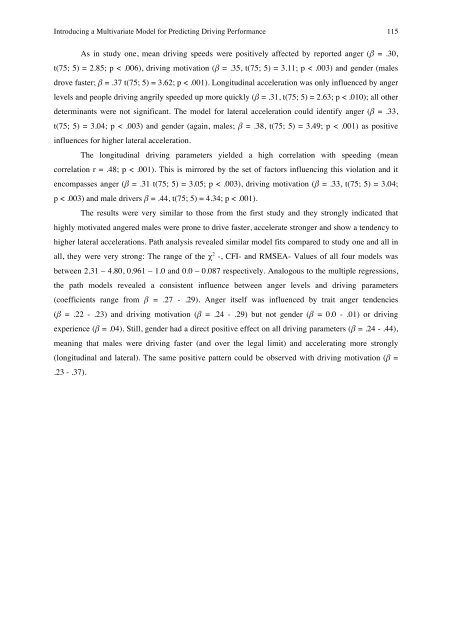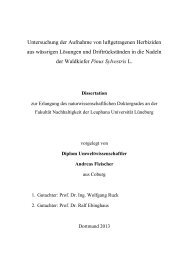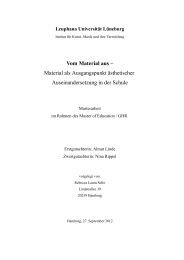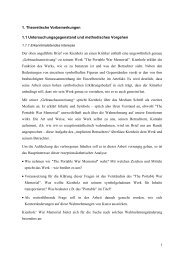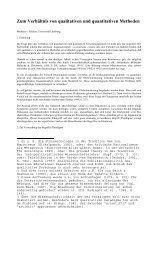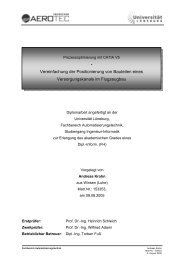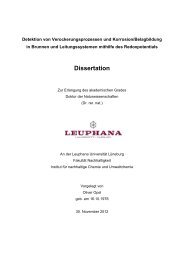Determinants of Emotional Experiences in Traffic Situations ... - OPUS
Determinants of Emotional Experiences in Traffic Situations ... - OPUS
Determinants of Emotional Experiences in Traffic Situations ... - OPUS
Create successful ePaper yourself
Turn your PDF publications into a flip-book with our unique Google optimized e-Paper software.
Introduc<strong>in</strong>g a Multivariate Model for Predict<strong>in</strong>g Driv<strong>in</strong>g Performance 115<br />
As <strong>in</strong> study one, mean driv<strong>in</strong>g speeds were positively affected by reported anger (β = .30,<br />
t(75; 5) = 2.85; p < .006), driv<strong>in</strong>g motivation (β = .35, t(75; 5) = 3.11; p < .003) and gender (males<br />
drove faster; β = .37 t(75; 5) = 3.62; p < .001). Longitud<strong>in</strong>al acceleration was only <strong>in</strong>fluenced by anger<br />
levels and people driv<strong>in</strong>g angrily speeded up more quickly (β = .31, t(75; 5) = 2.63; p < .010); all other<br />
determ<strong>in</strong>ants were not significant. The model for lateral acceleration could identify anger (β = .33,<br />
t(75; 5) = 3.04; p < .003) and gender (aga<strong>in</strong>, males; β = .38, t(75; 5) = 3.49; p < .001) as positive<br />
<strong>in</strong>fluences for higher lateral acceleration.<br />
The longitud<strong>in</strong>al driv<strong>in</strong>g parameters yielded a high correlation with speed<strong>in</strong>g (mean<br />
correlation r = .48; p < .001). This is mirrored by the set <strong>of</strong> factors <strong>in</strong>fluenc<strong>in</strong>g this violation and it<br />
encompasses anger (β = .31 t(75; 5) = 3.05; p < .003), driv<strong>in</strong>g motivation (β = .33, t(75; 5) = 3.04;<br />
p < .003) and male drivers β = .44, t(75; 5) = 4.34; p < .001).<br />
The results were very similar to those from the first study and they strongly <strong>in</strong>dicated that<br />
highly motivated angered males were prone to drive faster, accelerate stronger and show a tendency to<br />
higher lateral accelerations. Path analysis revealed similar model fits compared to study one and all <strong>in</strong><br />
all, they were very strong: The range <strong>of</strong> the χ 2 -, CFI- and RMSEA- Values <strong>of</strong> all four models was<br />
between 2.31 – 4.80, 0.961 – 1.0 and 0.0 – 0.087 respectively. Analogous to the multiple regressions,<br />
the path models revealed a consistent <strong>in</strong>fluence between anger levels and driv<strong>in</strong>g parameters<br />
(coefficients range from β = .27 - .29). Anger itself was <strong>in</strong>fluenced by trait anger tendencies<br />
(β = .22 - .23) and driv<strong>in</strong>g motivation (β = .24 - .29) but not gender (β = 0.0 - .01) or driv<strong>in</strong>g<br />
experience (β = .04). Still, gender had a direct positive effect on all driv<strong>in</strong>g parameters (β = .24 - .44),<br />
mean<strong>in</strong>g that males were driv<strong>in</strong>g faster (and over the legal limit) and accelerat<strong>in</strong>g more strongly<br />
(longitud<strong>in</strong>al and lateral). The same positive pattern could be observed with driv<strong>in</strong>g motivation (β =<br />
.23 - .37).<br />
!


